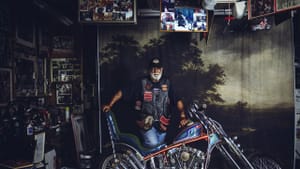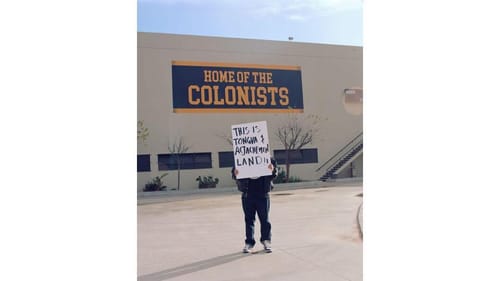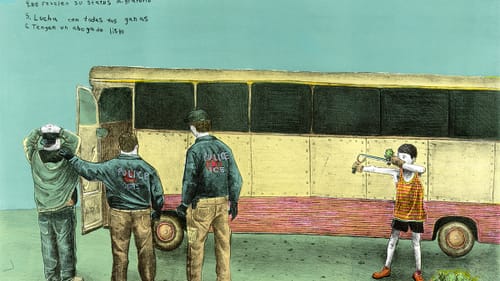Stay in the Loop
BSR publishes on a weekly schedule, with an email newsletter every Wednesday and Thursday morning. There’s no paywall, and subscribing is always free.
Artists head for the borders
The Print Center presents its 99th ANNUAL Solo Exhibitions

It may sadden Elon to learn that the Print Center’s 99th ANNUAL Solo Exhibitions are robustly diverse, equitable, and inclusive. Three artists, chosen from almost 500 applicants to the Print Center’s annual international competition, reveal the outsider experience in prints and photographs, enlightening viewers about people who, in the current political maelstrom, are unfairly dismissed, denigrated, and demonized.
Alanna Airitam: Black Diamonds: The Black Outlaw Bikers
Tuscon, Arizona-based Alanna Airitam recalls visiting museums and feeling that the people in the paintings were looking down on her, that she didn’t belong. As an adult, the Black photographer is filling in the gaps she sensed as a child.
Challenging conventions of subject and style, Airitam composes portraits of Black men and women with classical Renaissance elements: wearing velvet coats and lace jabots, draped in elegant fabrics, and surrounded by books and flowers. “I wanted to show abundance,” she said in the 2018 film From Haarlem to Harlem. “I wanted to bring this image to life of how I see Black people, as being rich, and abundant, and full of life.”
Airitam’s Black Diamonds portraits introduce the Chosen Few, a historically significant Black motorcycle club founded in 1959. Conducting themselves by a code of brotherhood and respect, they integrated when racial segregation was still legal. Airitam photographed members against 19th-century Hudson Valley School landscapes. The juxtaposition signifies the enduring adventure of exploration as it alludes to art’s exclusionary history. Club members look confident and proud. Among their many patches is a diamond-shaped design featuring a single fist—half Black, half white—and the words “Take None Give None.”
In JTown and Youngsta, Chosen Few Phoenix (2023), the two subjects stand together solemnly, in keeping with JTown’s vest, which memorializes members who’ve passed on. In his portrait, Boss Mike, Chosen Few Nomad President (2023) stands smiling in his garage, a knee propped on the seat of his bike. The workbench to his right, laden with tools and photographs, is in shadow, but the man and his motorcycle shine under Airitam’s spotlight.
William Camargo: The Sense of Brown
Stepping into his own frames, William Camargo becomes an avatar for marginalized and disrespected people of color. The artist, based in southern California, probes themes of gentrification and Chicanx/Latinx history through photography, installation, and public intervention. There’s a little of each in the series Origins and Displacements (2018-2023), Camargo’s pandemic-era project set in Anaheim, California.
In Ya’ll Forget Who Worked Here?! (2020), Camargo poses at a century-old fruit-packing building turned chic food hall. Except for his legs, he’s hidden by a large handmade sign reading “Brown women used to pack oranges here.” Camargo invades each image in this way, reminding onlookers of overlooked information about a location’s past.

A Colonist Is a Colonist Is a Colonist (2022) was taken at Anaheim High School (motto: “Because tradition never graduates”), where a football banner identifies the school as “Home of the Colonists.” In the photo, Camargo holds a sign announcing, “This is Tongva & Acjachemen Land!!” Elsewhere, he stands at a construction site before a fabric-sheathed chain link fence with this message: “This Area Will Gentrify Soon.” The more immediate issue is in the photograph’s title: We Gunna Have to Move Out Soon Fam! (2019).
The black-and-white series A Little Brown Interference (2022-ongoing) shows several images, mundane except for the presence of Camargo’s open left hand in each frame. It’s angled down from the wrist, fingers extended—as if being positioned for a handshake. One image is especially eye-catching: a rain-filled ditch divides a dirt road, a fence running parallel. Camargo’s hand spans the water, a visual version of the old phrase of the international alliance and maybe, his take on improving border security.
Juana Estrada Hernández: !Echale Ganas!
Juana Estrada Hernández arrived in the United States at age 7, undocumented, from Mexico. Now a legal resident and assistant professor of printmaking at Rhode Island School of Design, her practice addresses social and political problems affecting migrant communities. Her exhibition’s title is a family phrase of encouragement. Roughly translated, it means “keep going.”
Acknowledging that assimilation is essential to “survive and thrive” in the United States, Estrada Hernández says her artwork highlights “the importance of holding on to one’s own culture as a method of resistance, pride, and celebration.”
Estrada Hernández’s love of drawing and firsthand perspective are evident in colorful lithographs, snapshots of migration such as 2021’s Nopalaso en nombre de nuestras familias! (Nopalaso on behalf of our families!), in which Immigration and Customs Enforcement agents round up border crossers as a boy aims a prickly pear leaf at them with his slingshot. El Juego Americano 1 and 2 (The American Game, both 2023) depict the United States as a piñata; 2020’s Comida de mi madre (My mother’s food) is a surrealistic representation of a family leaving their comfortable home under a sky dominated by an enormous ear of maize.

Lo que no les enseñan parte 2 (What they don’t teach them is part 2, 2019), Estrada Hernández’s largest work here, consists of 10 monotype panels, mounted in two rows, and below them, a row of water jugs. The panels contain images of items migrants carry, and might discard, on their journey: an unzipped backpack, jeans, a child’s shirt with a tiny bow, a boot print, and a pair of squashed, laceless sneakers. Hanging below the panels are six paper mâché jugs made from paperwork related to Estrada Hernández’s numerous, ultimately successful, applications to the Deferred Action for Childhood Arrivals program.
ANNUAL jurors Drew Sawyer of the Whitney Museum of American Art and Claudia E. Zapata of the Blanton Museum of Art, with exhibition curator Lauren Rosenblum of the Print Center, have assembled a thoughtful dissertation on borders of all sorts. We all live in borderlands of our own making, of geography, race, and time, limited by artificial divisions which, if not challenged, make us vulnerable to people who take advantage of our fear, bias, and ignorance. Seeing things through fresh eyes is an effective antidote. We need to do more of it.
What, When, Where
90th ANNUAL Solo Exhibitions. Through April 5, 2025, at the Print Center, 1614 Latimer Street, Philadelphia. (215) 735-6090 or printcenter.org.
Accessibility
The Print Center building is a 19th-century carriage house with a historically certified façade. There is a small step at the entrance, leading to the first-floor gallery and gallery store. The second floor is only accessible by a flight of stairs. For more information, call (215) 735-6090.
Sign up for our newsletter
All of the week's new articles, all in one place. Sign up for the free weekly BSR newsletters, and don't miss a conversation.
